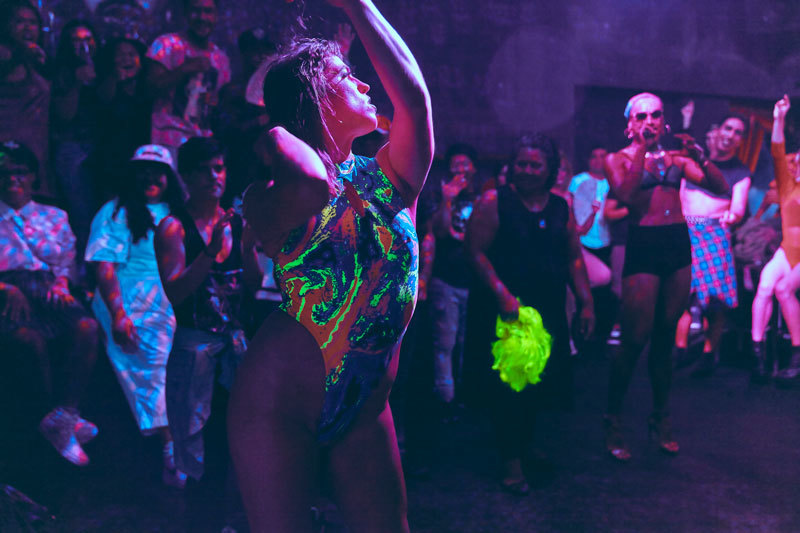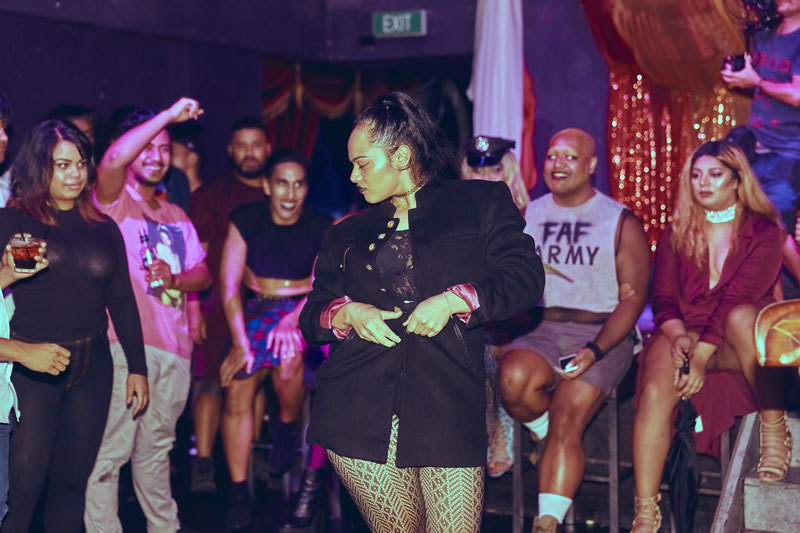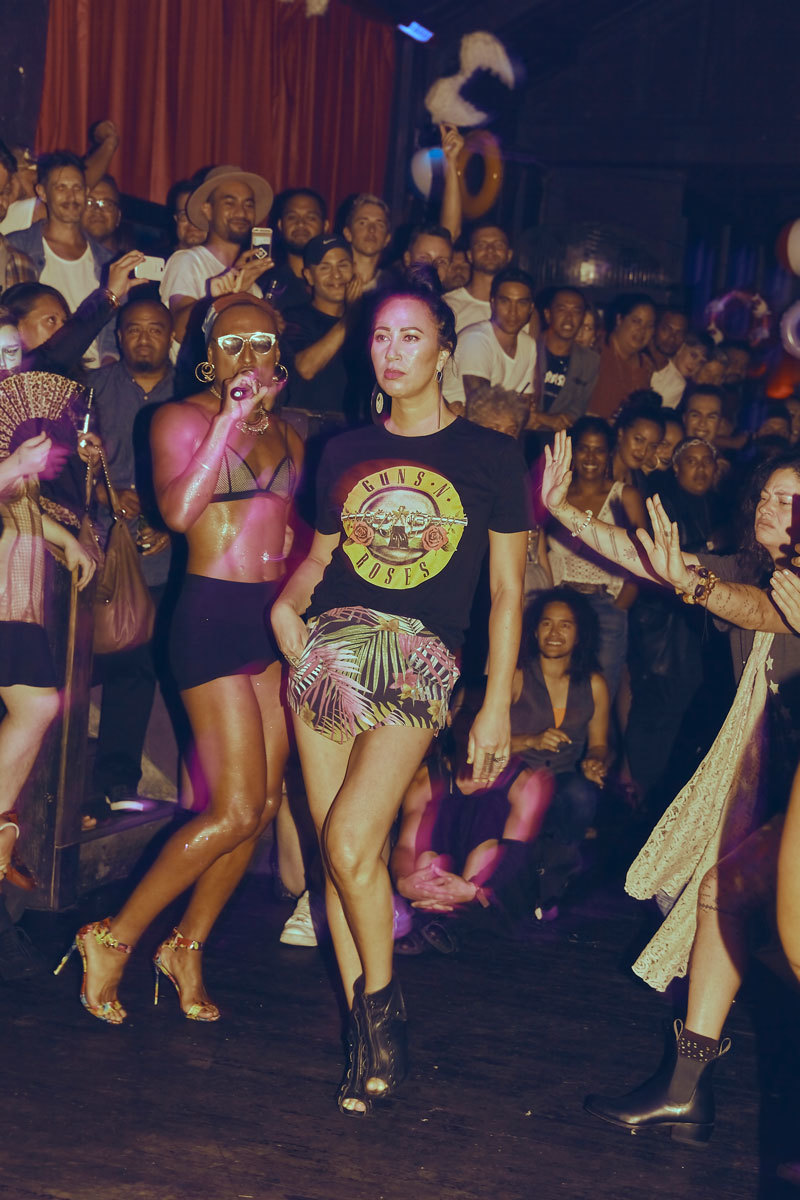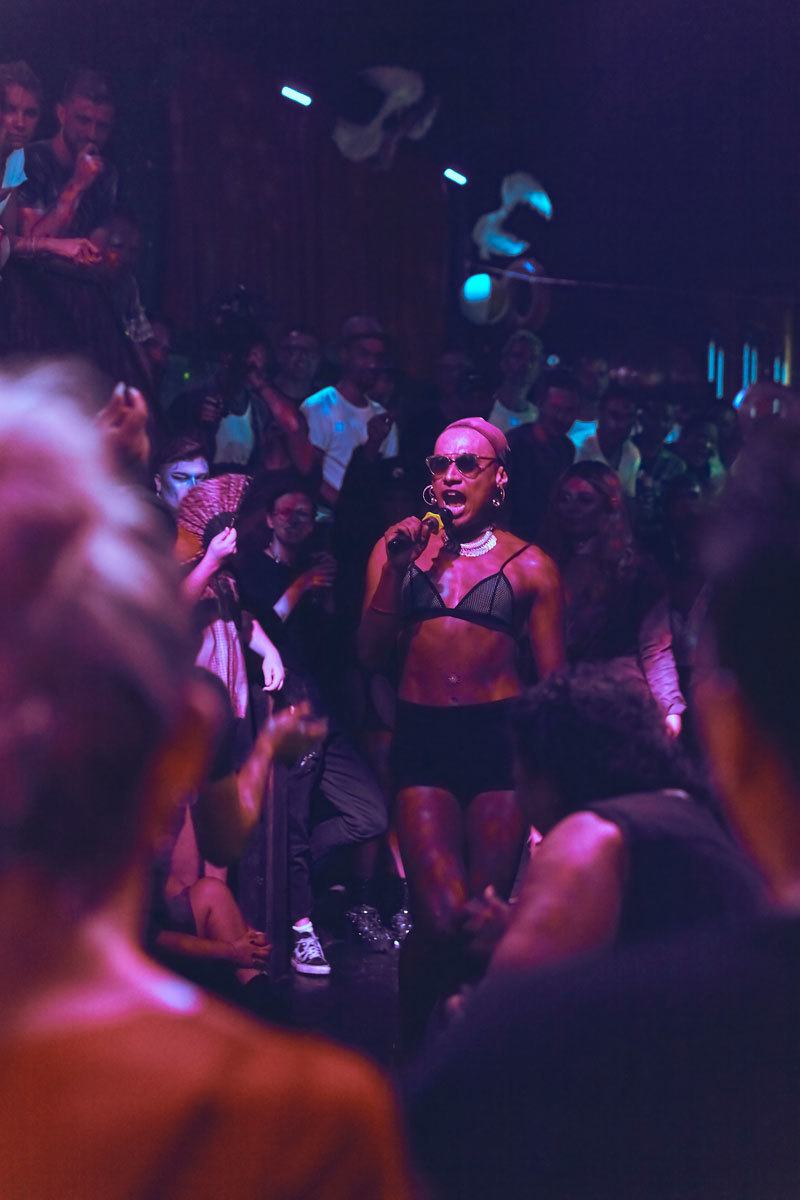Saturday nights on Auckland’s Karangahape Road are usually crowded. Bars and restaurants glow warmly, welcoming swarms of tourists and locals. And while cheap beer and good bands ensure the crowd is young and well dressed, it’s not the beloved, somewhat seedy, red-light strip it once was.
Tonight though, the crowd outside Family Bar draws more attention than usual. Beautiful kids in costumes of leather, plastic, lace, denim, and tartan cause passersbyto stop in their tracks. The group either doesn’t notice or mind, they’re used to attention. Some are masters of it.
Inside, the music has begun, growing louder and drawing people away from their final cigarettes and lingering friends. It’s already hot, but it will get hotter. By the end of the night, sweat will drip from the ceiling and the air will be thick and elusive as the crowd gasps for it. Akashi, tonight’s MC, takes the floor. People swarm her, as naturally as water pools around a stone. She begins, welcoming everyone to tonight’s FAFSWAG vogue ball.
Vogue has existed in the US since the mid-70s. Formed and finessed by queer kids in Harlem, it had spread to the rest of New York City by the 80s. If your only reference for the dance style — divided by techniques and houses and wielded as a weapon — is Madonna, then you’re painfully under-informed. It feels futile to even describe the moves — posing, dipping, jeering, runway — just YouTube it. Or better still, watch Paris is Burning, the quintessential 1990 documentary that explores New York’s intricate vogue ball competitions and culture.

That’s what Roy Aati did as a teenager. Spiking this information with clips he found online of dancers around the world, he didn’t have any underground clubs near his family home in South Auckland to test out his burgeoning moves. He practiced in his bedroom, in backyards, and lounges with the furniture pushed back. “I’d watch Paris is Burning and I felt like I was there one time, like in a past life, all those people seemed like they walked the same path I did,” he told i-D. Growing up as a queer pacific islander kid, surrounded by few role models who reflected him, voguing seemed like a point of familiarity. “In general (voguing) just has an attitude that’s so me, like: bitch I’m here, bitch I’m queer, and I’m not going anywhere.”
“Everyone in Paris is Burning, they were a bit of a lost soul who found solace through the ballroom scene. A lot of them were confused with who they were,” he continued. “That speaks for me — I had no one to look up to in the general Polynesian gay community.
Months before he’d make it to an Auckland ball, or meet any other dancers, the film teased new possibilities for a life outside of conservative suburbia. It suggested that if you didn’t feel comfortable in your own reality, you could spin a new one.
But the images he viewed online still felt far away. Like the majority of stars and legends currently defining the New Zealand vogue scene, the wider conservative Polynesian community he grew up in could still be uneasy with his sexuality. “I knew the ballroom scene through America, but I never thought it would exist in New Zealand, especially in the Polynesian community,” he admits. That changed when he discovered his first local ball on social media: “I wanted to learn more about it. I wanted to know where the whole Polynesian gay community was getting its confidence from. When I went to my first ball, I’ll be honest, I was quite shocked by how many openly gay Polynesians were up there. Polynesian boys in high heels, wigs, and makeup. I came from a very conservative family. It was a bit of fresh air.”

Roy would soon become friends with many of the dancers and fans crowding into Family Bar years later. Later tonight he’ll walk, clad in his usual low key jeans and long sleeve t-shirt, and be cheered by the judges who’ve loved his style since he first appeared out of nowhere. While many of the dancers grew up together, Roy emerged as an anomaly, his casual style making his explosive moves, honed in the privacy of his bedroom, even more exciting.
While still young, the New Zealand vogue scene is held up by legends and rules. During balls, a row of judges sit at the back of the stage on high stools. Like the rest of the room they click, chant, and cheer. When they aren’t happy with a performance or are concerned a competitor isn’t taking it seriously enough, they’ll slowly stand and the room will dissolve with joy. It’s a competition, but it’s one that celebrates rather than condemns: they throw shade by throwing down, treating observers to the moves that secured them a permanent seat at the back of the room, slightly elevated, impossibly sexy reminders of how good this can all look.
But despite the roars that a good drop will draw, voguing is about more than moves. The scene has afforded expression, but also created space. Jaycee Tanuvasa is a Trans Youth advocate, also from South Auckland. Speaking to members of the local vogue community, her name comes up a lot. Still in her early 20s, Jaycee has full legend status, not only for her moves but also her commitment to the LGBTQI+ community at large. She sits on the boards for Auckland PRIDE and Love Life Fono Trust — a group that supports LGBTQI+ Pacific communities — and is a central figure in a new South Auckland youth center.
When we meet her in the days before the ball she explains why events like this are so vital:
“For me, when I’m in our vogue scene on a Saturday night, that’s the most beautiful I ever feel. It only lasts a few hours because when I come back to the outside world I feel all these pressures and discrimination, my anxiety comes back. But in these moments and places, you’re never judged. People live for you, they see your body, they see your story, they see what you’re going through, support is there, and we don’t get that everyday.” For her these parties are a place to recharge, to be herself, to be celebrated, and not have to second guess what anyone thinks of her. To be the “best we can be and live and love each other…because we won’t get that outside.”

At the center of the Auckland vogue scene is FAFSWAG, an art collective who celebrate and explore LGBTQI+ Pacific Islander culture through parties, performances, exhibitions, and video projects. Many, but not all of tonight’s performers, are members of the collective. Sāmoan born Tanu Gago founded the group with his partner and fellow artist Pati Solomona. Like Jaycee, he’s sensitive to the role these events serve beyond being somewhere to dance on a Saturday night. “People don’t really talk about this, but the LGBTQI+ world can be an extremely lonely place,” he told i-D in 2016. “Pacific culture by nature is collectivist, so our people naturally gravitate toward one another and seek each other out.”
It was this ribbon between the past and present, community and queerness, that inspired the FAFSWAG team to begin holding these balls regularly. Frustrated by the lack of queer social spaces, Tanu continues, “We are outcast as society’s undesirables and slapped with dual minority statuses as queer and brown people. For this reason, it’s been important to carve out a place for our stories and for us to facilitate meaningful connections with our creative peers.”
To him, the people in this hot, noisy, electric room, pushing their friends to take part and screaming with joy when they slay, are doing more than building each other up. “We’re the kids of the migration and we’re redefining our place in the world — whether it’s our relationships, communities, theatres, universities, or our local art galleries. We are the authors of our own destinies. This means defining for ourselves what love, family, and identity looks like. It’s exciting and something we don’t take for granted.”

Tanu doesn’t need to look very far to see the impact of these events. At the edge of tonight’s line of judges is Jacob Tamata. Currently studying creative and performing arts, Tamata is one of FAFSWAG’s youngest members. Remembering what life was like before becoming involved with ball culture, he reflects, “My sexuality before, I wasn’t really comfortable with who I was. I knew I was queer, that was the first thing, but trying to combine that with my artistry didn’t go so well.” Continuing, he adds, “High school was so fucking shit. I couldn’t even stand to conduct myself in a place that didn’t have that recognition of queer people.”
After meeting Tanu and Pati he found a new insight into his own identity and culture. “The knowledge that they distilled in me gave me the leverage to move forward as an artist and say I can be capable of doing my own shit and you must not be afraid to tell your own stories.” Talking about it in the days before the next ball, he smiles. “Right now I’m really comfortable with my sexuality. I’m more than comfortable.”
At the end of the night, when the last dancers hit the floor in their final dips, the crowd once again spills out into the night air. It’s jarring to catch passersby staring. After being enclosed in this world for a few hours, their t-shirts and jeans seem so bare. Walking down this street earlier in the evening, everyone seemed like they had somewhere to be, something fun to do. Now, turning away from every-other-night back to the buzzing vogue family, matted in glitter and sweat, it’s hard to imagine spending time any other way. Dancers and friends take each other’s hands, pulling towards Sunday morning and a comment Roy made days before suddenly rings true: “I’m always going back. Even if there was no ballroom scene in New Zealand, I’d be voguing by myself in my lounge.”


Credits
Text Wendy Syfret
Photography Frances Carter
